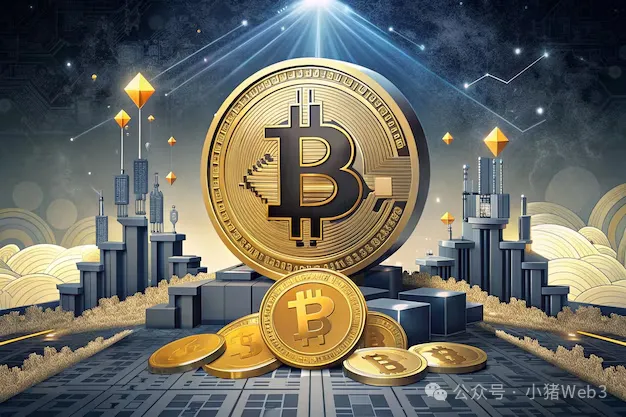introduction
In 2020, the author saw a documentary about blockchain technology - "Blockchain New", this documentary was shot in the decade of Bitcoin, that is, 2018, tells the story of the birth of Bitcoin, an important event affecting the development and change of the blockchain industry, when the price of Bitcoin was still hovering around $10,000.
Time flies, in the next few years, the blockchain industry has happened a lot of things, through the winter and summer, experienced destruction and rebirth, in December 2024, Bitcoin price has officially exceeded $100,000, Its market capitalization has overtaken Saudi Aramco to become the seventh largest global asset and is within a stone's throw of Alphabet (GOOGL) in sixth place.
The breakthrough of bitcoin price is not only a digital victory, but also represents an important turning point of cryptocurrency from marginalization to mainstream. This article intends to sort out the development process of bitcoin from gray to compliance with readers, the general introduction and classification of major cryptocurrencies, and the author's view on cryptocurrencies.
The history of Bitcoin

On November 1, 2008, an anonymous individual or group known only as Satoshi Nakamoto published a white paper titled "Bitcoin: A peer-to-peer electronic Cash System." By using a public, decentralized ledger (blockchain), and PoW (Proof of work) synchronous ledger mechanism (consensus mechanism), Bitcoin solves the problem of constant cryptocurrency issuance and circulation in the absence of a centralized institution at all.
On January 3, 2009, Satoshi Nakamoto created the Genesis block on a small server in Helsinki, the Netherlands, and left a message on the block, "The Times 03/Jan/2009 Chancellor on brink of second bailout for banks." (The Times headline of the day: Chancellor on brink of second bailout for banks.) ". Marking the official launch of Bitcoin.
On May 22, 2010, a user with the ID Laszlo Hanyecz successfully purchased two pizzas with 10,000 bitcoins by Posting a reward on the Bitcoin Talk forum. It was the first recorded payment using bitcoin, and 10,000 bitcoins, which cost about $30 at the time, are worth more than $1 billion today. It is worth mentioning that the 522 Pizza Festival, which commemorates this event, has become the biggest festival in the crypto circle.
However, the real use of bitcoin in the early days was in the notorious dark web - Silk Road (Silk Road), where the main transactions were drugs, sex slaves, arms and other illegal transactions, and Bitcoin became the payment tool for these illegal transactions. Between 2011 and 2013, Silk Road had more than 9.5 million bitcoins in circulation, accounting for 80% of the total bitcoin in circulation at the time.
In August 2013, Silk Road was destroyed, and Bitcoin went from the dark side to the bright side, beginning to attract the attention of some early institutions. In September 2013, Grayscale established the market's first Bitcoin Trust (GBTC). GBTC was the only investment product at the time that could be traded on the U.S. stock secondary market and track the price of bitcoin. The price of a single bitcoin was also pushed to $1,242.
This was also the time when early exchanges sprang up, and Mt. Gox became the largest bitcoin exchange at the time, with $4.5 billion in assets under management, accounting for about 70 percent of global bitcoin trading volume. However, in February 2014, Mt. Gox was hacked, resulting in the theft of 850,000 bitcoins, Mt. Gox debt ballooned, and eventually fell into bankruptcy. Affected by this significant negative impact, the cryptocurrency market as a whole collapsed, and the price of bitcoin fell from $761 to $321.
Coinbase is another early exchange, founded in May 2012, invested by Grayscale in 2013 and hosting bitcoins purchased by Grayscale using user subscription funds, Coinbase is now the largest cryptocurrency exchange in the United States by trading volume, and listed on Nasdaq in April 2021. Became the first cryptocurrency company to go public in the United States.
On December 11, 2017, the Chicago Board of Trade (CME) listed the world's first bitcoin futures. The price of Bitcoin also pushed sharply higher to nearly $20,000. In January, the price of Bitcoin was less than $1,000.

Micro Strategy is an enterprise software company engaged in business intelligence solutions. But since August 2020, Microstrategy has started buying bitcoin on a large scale, becoming the first company in a major U.S. stock exchange to include the big pie on its balance sheet. To date, Microstrategy has held about 440,000 bitcoins, making it the largest public company holding Bitcoins.
Tesla founder and CEO Elon Musk is also a proponent of cryptocurrencies. Tesla invested $1.5 billion in Bitcoin in January 2021. The price of bitcoin surged to more than $64,000 in April. Although the mid-May regulatory crackdown and other factors once fell below $20,000. But it hit $69,000 in November, the high of the last bull market.
However, in 2022, with the bankruptcy of FTX, the world's second largest centralized cryptocurrency exchange, the price of Bitcoin fell all the way down to as low as $15,500. Tesla also sold 75% of its Bitcoin holdings at the low point.
In January 2024, BlackRock spearheaded the industry's long-awaited Bitcoin Spot ETF (IBIT), which then launched a new wave of enthusiasm across the crypto market, and the price of bitcoin, which had been low for more than a year, began to break the $40,000 mark.
In November 2024, with the victory of Trump in the United States presidential election, the crypto market was completely ignited, and Bitcoin also ushered in a stronger rising market, continuously refreshing a record high, reaching a maximum of $108,000.
Other major cryptocurrencies

There are a large number of cryptocurrencies, and different categories of cryptocurrencies will be crossed or included, which is difficult to cover in just a few lines. Therefore, here we mainly introduce the three categories with the largest market capitalization: Layer1, Meme, and DeFi.
Layer1
Layer1 is another name for the underlying blockchain, Bitcoin, Ethereum (ETH), BNB, Solana, Sui are its typical representatives, responsible for supporting the infrastructure of the entire ecosystem. Even excluding Bitcoin, Layer1 is still the largest category of cryptocurrencies by market capitalization.
In November 2013, Russian-Canadian programmer Vitalik Buterin published a white paper titled Ethereum: The Next Generation of Smart Contracts and Decentralized Application Platforms. In contrast to the functionality of Bitcoin's single cash system, Ethereum is a decentralized global computer platform that can run smart contracts of arbitrary complexity. ETH (the native cryptocurrency of Ethereum) is the second largest cryptocurrency by market capitalization after Bitcoin, Ethereum pioneered the smart contract era of blockchain, was the beginning of Web3, and is the only cryptocurrency with a spot ETF.
In July 2017, Zhao Changpeng (CZ) launched the cryptocurrency exchange Binance, which today has become the largest cryptocurrency exchange in the world. Binance's Taiwan Dollar BNB is currently the highest market capitalization of Taiwan dollar, BNB can be used to enjoy transaction fee discounts and participate in new project issuance, while Binance has an EVM-compatible blockchain called Binance Smart chain, BNB can also be used as a Gas token on the Binance smart chain.
In September 2017, former Ethereum co-founder Charles Hoskinson launched Cardano (ADA), a PoS blockchain. Charles left in 2014 due to disagreements with fellow Ethereum co-founder Vitalik and set about developing Cardano, which aims to address Ethereum's shortcomings, including interoperability, scalability, and sustainability, and Cardano has been described as the original "Ethereum killer."
In November 2017, former Qualcomm engineer Anatoly Yakovenko released a Solana white paper introducing "Proof of History" (PoH) - a mechanism for keeping time between untrusted computers. With PoH, Anatoly set out to build Solana (SOL), which aims to implement a high-performance Layer1 whose software scales at the speed of hardware. Solana is not only the most successful "Ethereum killer", but also has been a representative of high-performance Layer1, compared to Ethereum, Solana has sacrificed part of the decentralization, but the performance has been improved by a hundred times.
In September 2021, Mysten Labs was founded by Sam Blackshear, Adeniyi Abiodun and George Danezis, former senior engineers in Facebook's (now Meta) encryption division. It launched the high-performance Layer1 Sui the following August. Sui writes its smart contracts through its own custom version of the Move language, employing an object-based data model that allows independent objects to process transactions in parallel, a design that enables Sui to achieve high throughput and low latency. Sui grew so rapidly in 2024 that it was dubbed the "Solana Killer."
Meme
Meme coin is also a digital asset that has attracted much attention in the field of cryptocurrency. Meme is more like a symbol of a cultural phenomenon that combines humor, creativity, and social interaction.
On December 6, 2013, programmers Jackson Palmer and Billy Markus created Doge, inspired by the popular Shiba Inu "DOGE" meme on the Internet. Palmer and Marcus' original idea was just to make a light-hearted, playful cryptocurrency that poked fun at the pomp and hype of the cryptocurrency scene at the time, with no regard for practical use. Dogecoin is not only the first Meme coin, but also Elon Musk's favorite cryptocurrency.
The representative projects of Meme coins are also the tokens SHIB and PEPE on Ethereum, and the tokens BONK on Solana. I won't go into details here.
DeFi
DeFi (Decentralized Finance) refers to an ecosystem of financial applications that run on a blockchain and are generally not controlled by any central authority or intermediary. Instead, they use smart contracts on a decentralized network to enforce and be bound by the terms of transactions, enabling users to complete transactions directly without the involvement of traditional financial institutions.
In the summer of 2020, the DeFi project broke out on Ethereum, all key indicators of the blockchain market have been significantly improved, and the entire cryptocurrency market value has increased by nearly 100 times, which can be said that DeFi is the largest innovation in the blockchain application layer at present.
DeFi projects can be further divided into stablecoins, decentralized exchanges (DEX) and lending, among others.
Stablecoins are further divided into centralized stablecoins (such as USDT, USDC, etc.) and decentralized stablecoins (such as MakerDAO (MKR) /DAI, ENA/USDe, etc.), stablecoins, as the name suggests, are anchored fiat currencies (mainly US dollars), maintaining a 1:1 conversion ratio.
DEX is represented by Uniswap (UNI) and Curve (CRV). Among them, Uniswap is the largest DEX on Ethereum, launched in November 2018, and Uniswap trading volume exceeded $450 billion in 2023, which not only accounted for about half of the entire DEX trading market, but also exceeded the spot trading volume of Coinbase, the largest exchange in the United States.
Lending is represented by AAVE, Compound (COMP). AAVE, one of the largest lending projects on Ethereum, was launched in November 2017. AAVE is a lending pool system that gives users the option to borrow, lend and earn interest on dozens of different cryptocurrencies without the need for an intermediary. There have been no major safety incidents at AAVE to date.
Sum up

When many people think of cryptocurrencies, they think of flood and casino scams. But now that it's almost 2025 and Bitcoin is above $100,000, it's time to look at cryptocurrencies with fresh eyes.
First of all, for most mainstream cryptocurrencies, it is already a highly liquid and high-value asset, of which Bitcoin will be included in the balance sheet of more companies in the future, and even be listed as a reserve asset in some countries.
Secondly, the cryptocurrency project can be regarded as an early start-up technology company, Layer1 as a SaaS company, Meme as a fashion brand, DeFi as a financial company, whose cryptocurrency has voting rights for the project, and some can also bear interest, which can be likened to the company's stock. However, the issuance of cryptocurrencies is not like stocks, which need to go through a long time to be listed, the threshold for issuing cryptocurrencies is low, and the project side can be issued directly after the design of the cryptocurrency economic model, so it has higher risks, and the speculation is particularly prevalent.
Finally, Web3 is a technological revolution in human history, cryptocurrency is both a component and a side effect of it, there may be a financial bubble in cryptocurrency, but the bubble is always around transformative technology, we can look at the development of Web3 and cryptocurrency more leniently.
In the world of Web3, you can be an investor, a KOL, a wool party, a developer, or just a witness, the market has greed and fear, human nature has despicable and noble, belonging to the Web3 adventure era has been opened, the sun of The Times have shadows, and people who are not willing to take risks, are not in the sun.
